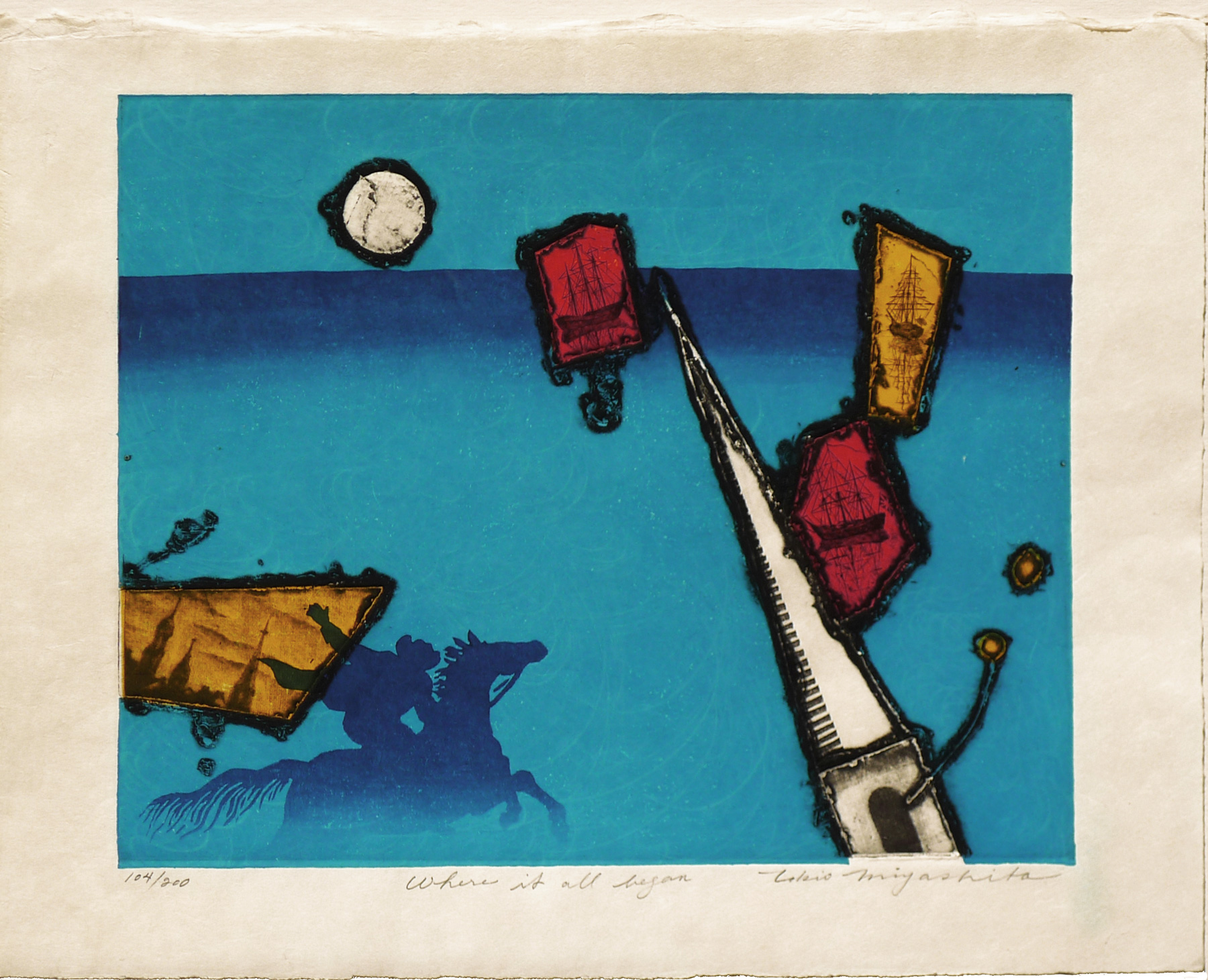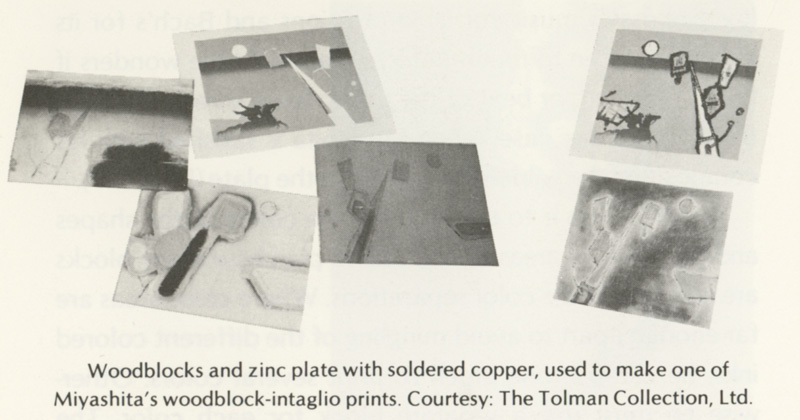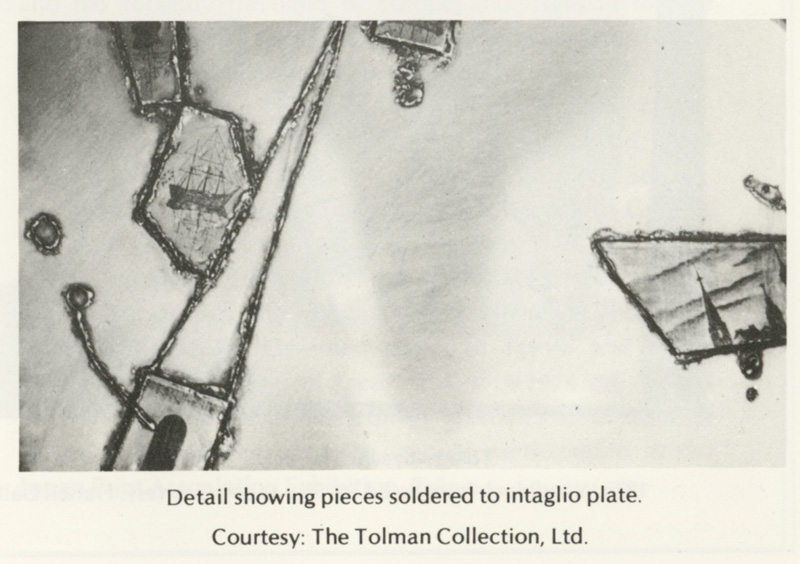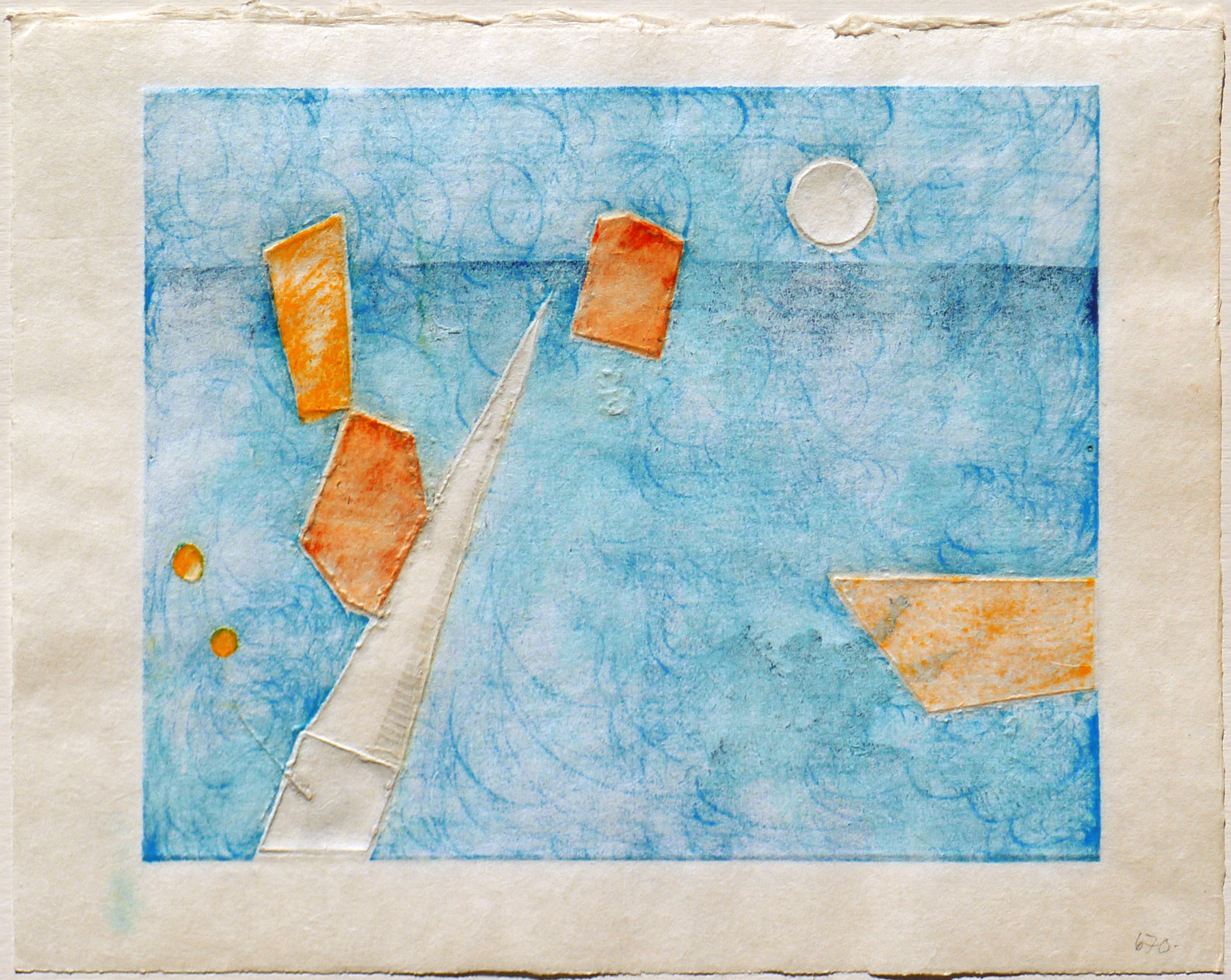About This Print
East meets West in my prints - Tokio Miyashita1
"Paul Revere, the belfry arch of the Old North Church, 'two if by sea,' the Somerset man-of-war, even the spires from the green of some Middlesex village, all appear in this work, which could possibly serve as an illustration of Longfellow’s famous poem. Miyashita works in his usual combination of woodblock and intaglio."2
| And a challenging marriage it is, of traditional Japanese and traditional European processes. Miyashita uses the Ukiyo-e woodblock technique requiring water-based inks and absorbent paper. On the same print he uses intaglio techniques demanding oil-based inks and a paper that responds sensitively to these inks, and, at the same time is strong and resilient enough to take the pressure of the etching press. Kikuzki Kozo is the paper that has the necessary characteristics. It has tough fibers and accepts both water-based inks and oil-based inks. To offer the appealing characteristics of both processes, Miyashita prints color areas from woodblocks and overlays these with details and contours printed from an intaglio plate inked in black. He first composes and assembles the intaglio plate cut from a zinc sheet to appropriate print size. On the plate he assembles assorted sizes and shapes of zinc or copper plate with details added by etched or scratched lines. Sometimes he adds found object, such as stamped metal fragments or even old photo-engrave plates... Miayashita moves these pieces around on the plate until he achieves an effective juxtaposition.... [W]hen he is satisfied with his composition, he solders the pieces to the plate. [See below photos.] The next step is to decide what the colors of the shapes and background areas will be and to plan how many blocks are needed for the color separations. Where color areas are far enough apart to avoid mingling of the different colored inks, he can use one block to print several colors. Otherwise he must use a separate block for each color. The blocks must be the same size as the zinc plate. The image is then transferred from the plate to these woodblocks. To do this, he inks the plate image, wipes off the excess ink, and places the plate on the bed of the etching press. He lays a paper over this and runs both through the press, thereby transferring the inked image onto the paper. Next he places the paper, ink-side down on the woodblock, and rubs the top side wit a baren to transfer the ink from the paper to the block. This transfer process is repeated for each block he will need. This method of double-transfer - from plate to paper to block - assures a positive image on the woodblocks in proper registration with the metal plate. If the image were transferred directly from plate to block, the image would be in reverse as seen through a mirror. The blocks are now ready to be carved. Miyashita cuts away the parts of the block not to be printed; the small shapes to be printed are left as islands on the plywood sheets, while the background areas are left intact except for the smaller shapes which he carves away - the same shapes taht are islands on other blocks. When the blocks are cut, he is ready to ink and print them in the standard Japanese method. Miyashit uses poster-color directly from the jar, diluting them as needed with water. He does nto mix colors before applying them to the block. He does, however, merge one color into another on the block to create bokashi effects... To do this consistently from print to print in an edition, he marks this clothesbrush-shaped brush according to where to load the colors. With the colored inks in the brush he sweeps it across the block precisely along the same course for each print. To build the pigment on the paper sufficiently in both the bokashi and flat-color areas, Miyashita may need to brush each color onto the block many times to make repeated printings. By this means, he achieves the velvety rich color characteristic of his work. All of the color areas must be printed on each paper of an edition before the intaglio image can be printed over them. He then hangs the paper to dry. Before printing the zinc plate he must wet the prints again using a wide brush to lightly spread the water. Miyashita then inks the zinc plate. He rubs the black oil-base dink over the entire surface, working it into all the crevices. Then...he carefully wipes the ink away form the smooth surfaces. If he leaves a thin veil of ink on these surfaces by choosing not to wipe them clean, a subtle patina is added to the whole print, deepening the richness of the underlying block-printed colors. It is the different thicknesses of black ink - from the heavy black around the rough solder contours, to the delicate tones of the etched, and drypointed details - that add the jewel-like quality to the imagery. While the solder-contours may look crude on the plate, these same projecting lines, when inked and printed, make a natural looking soft outline for the shapes of color they encompass. By combining two techniques of vastly different origin and character, Miyashita has melded his own form of expression: bold, bright, rough-hewn, yet refined and singularly elegant in effect. The viewer's imagination may bring its own meaning to the work or the visual feast itself may be enough. |
verso - click on image for detail
1 Japanese Prints Today: Tradition with Innovation, Margaret K. Johnson, Dale K. Hilton, Shufunotomo Co., Ltd., 1980, p. 213.
2 website of University of Puget Sound, "Artwork in the Library: 7 Samurai and The Bicentennial" http://www.pugetsound.edu/academics/academic-resources/collins-memorial-library/explore-the-library/artwork-in-the-library/7-samurai-and-the-bicentennial/Print Details
| IHL Catalog | #892 |
| Title | Where it all began |
| Series | |
| Artist | Miyashita Tokio (1930–2011) |
| Signature | Tokio Miyashita in pencil |
| Seal | not sealed |
| Date | undated, but likely 1976 |
| Edition | 104 of 200 |
| Publisher | artist |
| Impression | excellent |
| Colors | excellent |
| Condition | excellent - minor printer smudge in lower right margin; two pin holes edge of image in center |
| Genre | sosaku hanga (creative print) |
| Miscellaneous | |
| Format | |
| H x W Paper | 13 3/8 (not including deckle top edge) x 17 1/8 in. (34 x 43.5 cm) |
| H x W Image | 11 x 13 5/8 in. (27.9 x 34.6 cm) |
| Collections This Print | British Museum 1983,0602,0.2 |
| Reference Literature | Japanese Prints Today: Tradition with Innovation, Margaret K. Johnson, Dale K. Hilton, Shufunotomo Co., Ltd., 1980 (plates used for this print illustrated) |





